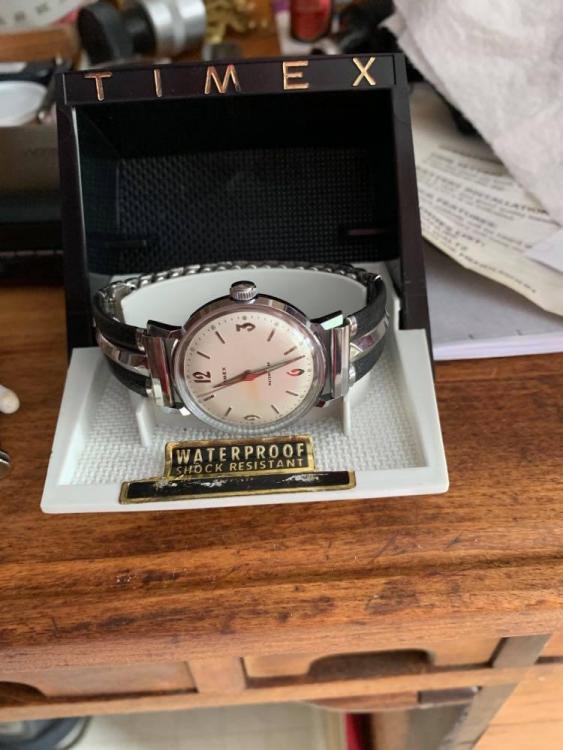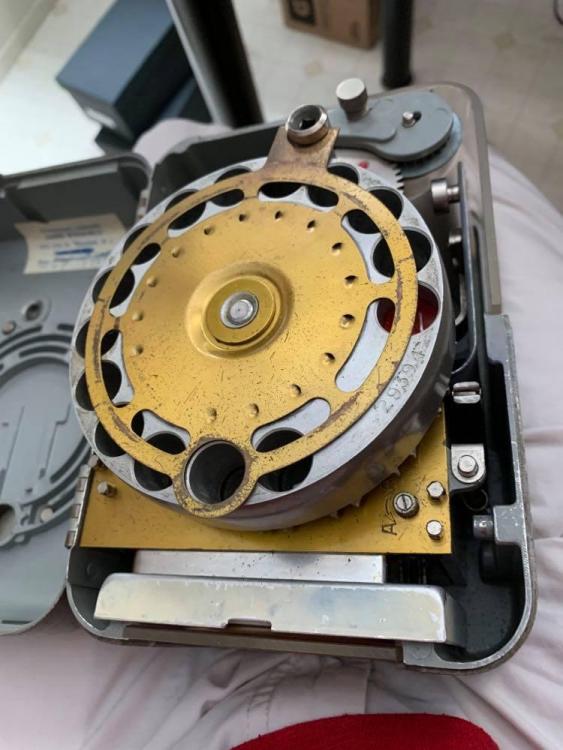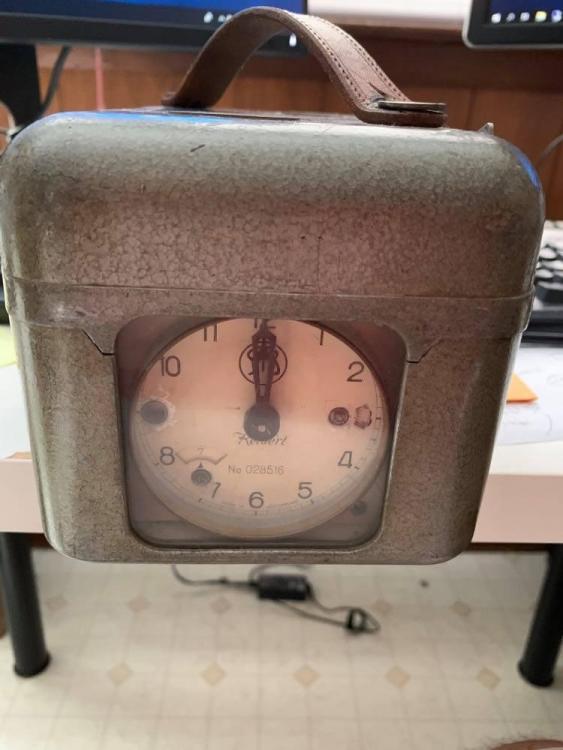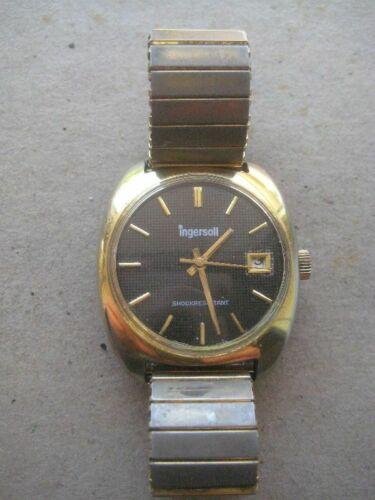Leaderboard
Popular Content
Showing content with the highest reputation on 08/10/20 in all areas
-
The standard is with the roller centered with the arms, it the most aesthetically pleasing, also means the arms are not obscuring the fork when setting up the escapement, and makes visually checking the amplitude easy. As the roller is not poised, it does have an effect on the balance poise. So balances are always poised with the roller in place. For fun, reverse the position of roller and hairspring 180 degrees on a watch with a good rate in the vertical positions. It goes way out. On 3 arm balances it can really be anywhere. If in doubt after replacing a staff, bet on placing the roller jewel opposite where metal was removed to poise the balance.3 points
-
Have a look at this: https://adjustingvintagewatches.com/restoring-enamel-watch-bridges/2 points
-
To answer the original question - the ring is to put the handle into to protect it so you don't press the plunger accidentally while fooling with the spring. You can sit the handle into it so you can work on the with the handle upright and the plunger protected.2 points
-
I don't want to discourage you from your goals but you may have some challenges with this one. In case you don't have the technical sheet I've attached it also the link to the rest of the tech sheets. At least with Seiko's OEM watches you do get more technical specs and specifications on timing. Unfortunately typically for timing these watches are not typically the best. although if you look at the list they actually lists some watches as being premium and their timing specifications such as the NE15 I'm currently looking at does have better timing specifications. you'll never actually get true chronometer because the balance wheel and hairspring are not of chronometer grade. but nothing wrong with trying and having some fun. Fortunately it has the etachron system which improve slings and allows for greater range of regulation. Such as if the balance wheel should lose some of its weight? Statically poising the balance would help but you could also dynamically poise this would lighten the wheel little bit as long as you're careful and you should easily build a regulate that out. Then, watch sell better keep time in different positions. https://www.timemodule.com/en/product-and-download.php?list=1 Seiko NH35_TG.pdf2 points
-
2 points
-
Hi and welcome to the forum If the stem is not engaging it sounds like problems with the keyless work like the setting lever or setting lever spring displaced or broken, so dial and hands off and check the positioning of bothe the afore mentioned parts. There is precious little tech information on these movements.1 point
-
1 point
-
1 point
-
Hi Peter I have attached the Series 3X tech guide and the NH36 tech sheet. The Tech guide has all the parts and the oiling plus assembly information hope you find it useful. jdms suggestion of sourcing bits from ebay may be the best course of action of see If you can lay you hands on a Bombay special from India or check out cousins uk. cheers Seiko NH36 (1).pdf Seiko NH3 Series.pdf1 point
-
Hi Nucejoe I have dug up the AS5100 tech and the 5200, the lemania and the Omega are already posted so a comparisson could be made cheers AS 5100, 5101, 5102, 5103, 5104, 5106, 5150, 5151, 5152, 5153, 5154, 5156.pdf AS 5200, 5201, 5202, 5203, 5204, 5206 (1).pdf1 point
-
1 point
-
My rule of thumb is that you want to stay above and away from 220 as that's when the effects of balance poise errors get flipped and magnified. Your movement dipping in and out of 220 isn't doing it any favors in terms of positional consistency.1 point
-
my latest project. A Roamer watch. Servicing skill full of flaws but I’ll try to make it better for the next one.1 point
-
That's awesome! I'm going to try that on some of my scrap bin parts and so how it goes. I've already got everything on hand except for the denatured alcohol. I'll have to pick some up on my next run to town. All of what we have now is "good natured alcohol".1 point
-
The roller table looks to be out of position, the roller jewel is normally at 90 degrees to the arms. Add to that the hairspring is likely not correctly positioned I agree that you are way out of beat.1 point
-
The simpler explanation is that you're installing with the impulse pin outside of the horns. Depending on the mov't you can actually see if that is the case. When it happens like that, leave the cock screw lose, and lift the balance so slightly that it can fell within the horns. Assuming there is at least some power it will start beating right away. Just a passing note, it is said impulse jewel that makes the pallet move, not vice-versa.1 point
-
Sorry then, I had forgot there is a limitation there.1 point
-
Yea I know sir Was trying hard to achieve 30poat so I can post at the subsection while still posting my video tho ^^” roger that anyway cheers1 point
-
I suspect it is a mile out of beat. I sugest you remove the balance & the pallet folk & re-install the balance & check where the impulse jewel is in relation to the banking pins. It should settle in the middle when it stops oscillating.1 point
-
Just to make you aware that if all you intend to do is posting videos there is a dedicated subsection for that.1 point
-
The epilame is a surface treatment which changes the surface tension. This ability makes the oils be more collected into one spot, you get the same result when you clean a pallet jewel good and polish it with for example a bit of leather on a stick. When you put a drop of any liquid in a highly polished surface the drop will be set in one place like a small ball. The epilame creates a similar function but also keeps the oil in place. I personally only use epilame on spots where the angle of rotation is higher like on pallet fork jewel faces, the escape wheel, the cap jewels, pivots of the seconds wheel and reverser wheels. In these places the epilame helps to keep the oil in place instead of squirting away. A secondary bonus is the epilame makes the oiling a bit easier but that isn’t the products main purpose. I would only use Moebius 9010 on highspeed and low torque places like cap jewels, escape wheel and seconds wheel, it’s a very light oil. On pallet jewel faces I personally only would use Moebius 941 or Moebius 9415. The Moebius 941 is an oil purpose made for pallet faces, with this I recommend the use of epilame to keep it in place. Time flies and with it the development of lubricants. To get the latest data from for example Moebius one could visit their official site. http://www.moebius-lubricants.ch/sites/default/themes/moebius/extras/pdf/tableEN.pdf I personally don’t use Moebius 8000 anymore I gone fully synthetic all the way. The Moebius 9415 is considered a thixotropic grease which will change properties when subjected to pressure. At first it is firm grease and changes to liquid when hit by the escape club impulse face. So if you don’t use epilame then the choise is Moebius 9415. A bonus is if you know the history of the watch, the epilame surface treatment doesn’t wear away immediately but survives 2 or three services. So, you don’t need to use it at every service, in the best of worlds you treat a watch in every 12-15 years interval so in the long run those 150$ will go a long way. This is a topic that pops up now and then and is covered in other threads and my final thought still is why one should lubricate a gem like a watch different in hobby use than if you would get it lubricated professionally? The price for a watch service often comes with a high price tag because it usually isn’t cheap to service a mechanical watch in the correct way. Doing it you self will save you the cost of manhours.1 point
-
the problem with lubrication charts is they do not necessarily have dates on them and changes can and do occur I have a link below where you can download the newest version of the chart at least I assume it's the newest version on the website. peculiar wording on the chart but you're looking at this line "Escapement lift and escape wheel" 9415 or the oil version 941 and of course everyone's favorite 9010. Of the 3 9415 is going to stay the best without surface treatment the other two really should have surface treatment. Although ideally depending upon which company you look at practically the entire watch is supposed to be surface treated. http://www.moebius-lubricants.ch/en/products/oils1 point
-
For pallet stones Moebius recomends 8000. Here is a link to there chart. https://blog.esslinger.com/moebius-oil-charts/1 point
-
1 point
-
Hi WW, I have an AS-5100 complete balance, fits zenith 5100, any relationship or interchangability with lemania 5100 or Omega 1045, or are the two different creatures, I wonder if spec of balance complete can be gathered from techsheets? or other sources? TIA joe1 point
-
Sounds like a easy fix on the original movement if the hair spring is stuck together. I would keep the original in it and change out the fancy winding weight off the new movement.1 point
-
Don't know unless you provide pictures of the spare movement I'm afraid. You will need a jumper, driving wheel, and dial washer in addition to the day wheel. It's a crapshoot whether or not you get all, some or none of these parts included on a movement meant for date-only. More than likely you're going to need to transplant at least some of these parts to the one you intend on using from the extracted movement. If it was up to me I would try and save the old movement. Taking the original Valjoux out of this watch and sticking in a modern ETA would likely have a negative impact on its value.1 point
-
Hi Lemania 5100 is used in the Omega 1045. I have attached the tech sheet for the omega 1045 and the technical instructions for the Lemania 5100. Hope you find them us ful 1283_Omega1045 (2).pdf 5188_Lemania5100_Technical Instructions_Smaller (3).pdf1 point
-
1 point
-
I have some NOS parts including some discontinued parts to lemania 5100, should you come to need any of what I have, be happy to gift wrap em for you. Wonder if they go to use before I kick the bucket.1 point
-
The auto system on this caliber is very simple. The reverser is really just a pinion on the rotor which is held in one direction by a click spring. The pinion needs to turn freely (minus the spring) on the rotor, and be lubricated. When hand winding the pinion spins past the click; if the lubrication has become sticky the rotor will spin. Use a plastic pointed stick (or two) to remove the clip holding the rotor on, it's very easy to scratch the rotor with metal tools. If you do a full service on it, beware of using alcohol on the date support (it's a full plate made of acrylic that covers the dial side)- alcohol will damage it. It's possible that the latest executions changed the plastic but I don't think so. I wouldn't recommend it as a first chronograph, it's a robust movement but has some tricky parts to deal with. Here's a manual1 point
-
Clean and check winder module, treat with epilame fixdrop, be prepaired to replace the reverser with new. Good luck1 point
-
this is a nice specification that Mark has specified. A better specification would be to follow what the watch companies specify. as your watch is a clone of a Swiss watch I'm going to use their timing specifications this would be for 6497/98 – 2. But before we get the specification remember your movement is a Chinese clone we don't know how well they manufactured. So to get your maximum amplitude everything has to be really good and of course the watch has to been manufactured to proper specifications. You need to check every single pivot and jewel as stated above by jdm. another place were going to have timing differences of the Chinese versus the Swiss is we don't know how well the Chinese manufacture their mainspring. one of my amusements with this group is Mark's example above amplitude you'll continuously see everyone's concerned about amplitude where as if you fix watches for customers they're usually concerned about something different like timekeeping. Watch manufacturers are concerned about timekeeping with a tiny bit of amplitude. various watch companies put their timing specifications in a variety of locations. Rolex actually has it specified in their service sheets. Omega puts it in a separate instruction sheet. ETA puts it in the manufacturing information sheet which I'm attaching so you can see it for reference and I'm going to snip out some things and attach those. as far as amplitude goes the watch companies are concerned about a maximum too much is bad typically for most watches at 300°. Then they are concerned about amplitude at the end of 24 hours running. Typically it's 200°. but as not entirely written in stone some companies like Omega will accept a lower amplitude for certain watches as long as the watch still keeps time. then for your example it's always good always timer watch in six positions it makes it much easier to find problems. But remember that the manufacturer usually does not specify six positions unless it's a chronometer grade watch. Even Rolex only times in five positions. So this watch is a three position watch.what would've been interesting to see is providing your movement is brand-new as it's a Chinese clone I assume it was it would've been nice to run timing on the brand-new movement versus what happens after you service. As after should always be better than before. ETA 6497-2 Manufacturing Information.pdf1 point
-
Also have this beauty coming. Sent from my SM-N975U using Tapatalk1 point














